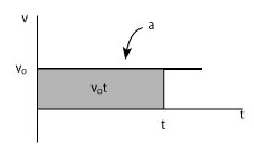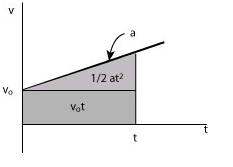Equations of Motion
Helena Dedic
Derivation of Equations of Motion
Consider a v-t graph for an object moving with constant velocity.
• Motion with constant velocity implies that the acceleration is equal to zero and therefore the v - t graph is a horizontal line.
• The displacement is the area under the v - t graph
We write
• Motion with constant acceleration implies that the velocity is a linear function of time. Given that the initial velocity is we can write
where the acceleration is the slope of the graph and is the intercept.
• The displacement is the area under the v - t graph
We write
• The displacement in both cases is
• There are two independent equations describing motion with constant acceleration and five variables: , v(t), , a and t. Consequently, in any problem we can solve for two of those variables and three other must be given.
• We can derive another useful equation by eliminating t from the two equations above.
We begin with equation
We isolate t:
Then we substitute for t in the equation for the displacement:
We will now multiply both sides by 2a. This step will eliminate fractions from this equation.
This leads to:
Expanding:
which leads to:
This can finally be written in the form:

